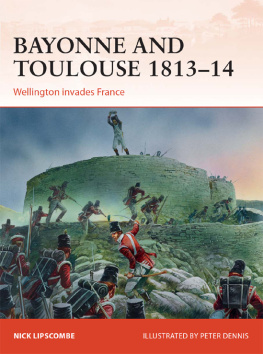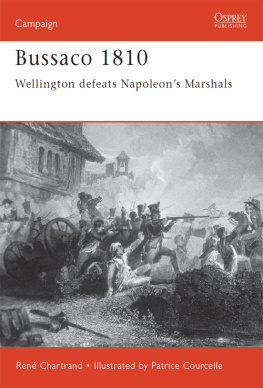Bruce Collins - Wellington and the Siege of San Sebastian, 1813
Here you can read online Bruce Collins - Wellington and the Siege of San Sebastian, 1813 full text of the book (entire story) in english for free. Download pdf and epub, get meaning, cover and reviews about this ebook. year: 2017, publisher: Pen and Sword, genre: History. Description of the work, (preface) as well as reviews are available. Best literature library LitArk.com created for fans of good reading and offers a wide selection of genres:
Romance novel
Science fiction
Adventure
Detective
Science
History
Home and family
Prose
Art
Politics
Computer
Non-fiction
Religion
Business
Children
Humor
Choose a favorite category and find really read worthwhile books. Enjoy immersion in the world of imagination, feel the emotions of the characters or learn something new for yourself, make an fascinating discovery.
- Book:Wellington and the Siege of San Sebastian, 1813
- Author:
- Publisher:Pen and Sword
- Genre:
- Year:2017
- Rating:5 / 5
- Favourites:Add to favourites
- Your mark:
- 100
- 1
- 2
- 3
- 4
- 5
Wellington and the Siege of San Sebastian, 1813: summary, description and annotation
We offer to read an annotation, description, summary or preface (depends on what the author of the book "Wellington and the Siege of San Sebastian, 1813" wrote himself). If you haven't found the necessary information about the book — write in the comments, we will try to find it.
Wellington and the Siege of San Sebastian, 1813 — read online for free the complete book (whole text) full work
Below is the text of the book, divided by pages. System saving the place of the last page read, allows you to conveniently read the book "Wellington and the Siege of San Sebastian, 1813" online for free, without having to search again every time where you left off. Put a bookmark, and you can go to the page where you finished reading at any time.
Font size:
Interval:
Bookmark:

Wellington and the Siege of San Sebastian 1813
Bruce Collins

First published in Great Britain in 2017 by
Pen and Sword Military
an imprint of
Pen and Sword Books Ltd
47 Church Street
Barnsley
South Yorkshire S70 2AS
Copyright Bruce Collins, 2017
ISBN 978 1 78383 114 2
eISBN 978 1 52670 370 5
Mobi ISBN 978 1 52670 369 9
The right of Bruce Collins to be identified as the author of this work has been asserted by him in accordance with the Copyright, Designs and Patents Act 1988.
A CIP record for this book is available from the British Library
All rights reserved. No part of this book may be reproduced or transmitted in any form or by any means, electronic or mechanical including photocopying, recording, or by any information storage and retrieval system without permission from the Publisher in writing.
Pen & Sword Books Ltd incorporates the imprints of
Pen & Sword Archaeology, Atlas, Aviation, Battleground, Discovery, Family History, History, Maritime, Military, Naval, Politics, Railways, Select, Social History, Transport, True Crime, Claymore Press, Frontline Books, Leo Cooper, Praetorian Press, Remember When, Seaforth Publishing and Wharncliffe.
For a complete list of Pen and Sword titles please contact
Pen and Sword Books Limited
47 Church Street, Barnsley, South Yorkshire, S70 2AS, England
E-mail:
Website: www.pen-and-sword.co.uk
View of San Sebastian by James Webb, 1870s
San Sebastian, 1874 by James Webb
Depot Generale de Marine, Baie, port et ville de St Sebastien, 1793
Storming of the town and castle of San Sebastian
British troops advancing, San Sebastian
The Storming of San Sebastian by Denis Dighton
Bridge of boats across the Adour
Bayonne from St Etienne
Captain Sir George Ralph Collier by William Beechey
Joseph-Dsir Court, Le Marchal Soult
Sir Michael Howard records that when, in the mid-1950s, he cast around for a research project, The Napoleonic period seemed to have been flogged to death by operational military historians. Subsequent work, he freely admits, revealed the erroneous nature of this initial judgement. But something similar might be thought today, especially as bicentenary publications have climaxed with numerous re-workings of the battle of Waterloo.
In fact, the subject continues to be open to fresh approaches and re-appraisals. Distinguished work has provided new insights into, among other topics, the British governments policies and strategic directives, the operational skills demonstrated by Wellington, the recruitment of troops and the creation of the army, the conditions under which the British soldiers campaigned and fought, and the Spanish experience of the war. Recent publications, however, leave open the question of how useful operational studies might still be to understanding the British army in this period.
This study arose from a broader interest in British siege warfare from the late eighteenth century to the South African War of 18991902. One aspect of that interest is the conduct of three sieges of the capital of Mysore, Seringapatam (Srirangapatnam), during the 1790s. The campaigns against Mysore involved the future Duke of Wellington who served in neighbouring Madras from 1796 to 1805. I offered some preliminary observations on possible connections between Wellingtons Indian experience of sieges and his conduct of sieges in the Peninsular War in November 2005 at a conference organized by the British Commission for Military History on Land and Sea Warfare in the Age of Nelson and Wellington. That interest was subsequently developed at the Third Wellington Congress at the University of Southampton in July 2006 in a paper published in C.M. Woolgar (ed.), Wellington Studies IV (2008). From that point, I decided to re-examine the longest and most difficult of Wellingtons sieges, that of San Sebastian.
Any study of the British experience of the Peninsular War will recognize the importance of Charles Omans monumental history. I have chosen not to pick my way through his chapters on the siege but to explore the subject with different questions in mind. By re-working the history of the siege, I hope in particular to demonstrate the overriding and unremitting demands of managing an army and its operations. This perspective is intended to qualify the importance so often attached to strategic insight and charismatic leadership in the history of campaigning. It is difficult to do justice to the actions and skills of senior battalion and brigade officers, because evidence is limited and events are opaque. What follows is therefore an exploration of a particular campaign highlighting the challenges of managing complex operations.
The sacking of San Sebastian after the siege created a great deal of controversy in Spain and a cultural history of the nature and bounds of that controversy could be written. One footnote to that cultural history might be added. Oman concluded his account of the siege by regretting the disgraceful sack which followed the storm, but also by describing a ceremony of Anglo-Spanish reconciliation in 1925. Demonstrating for Oman that the present generation has forgotten and forgiven that sad story, a monument to the British dead was erected on the mountain where the castle stood overlooking the town itself. Eighty years later, the site remains sad and neglected, even disturbingly so. In many various ways, the response to the siege within the Basque country and in Spain more generally would make an intriguing subject for research.
But my concern here is with British military history and with the implications of a close examination of one siege for our understanding of early nineteenth-century warfare more generally. Sieges had once been central to the conduct of war. By the 1800s the conduct of sieges was not seen as a vital component of Napoleonic warfare. Yet siege operations proved important in the Peninsular War and posed major military and moral challenges. This study offers a contribution to the re-examination of the British engagement in sieges during their long wars of 17901815 and indicates that the nature of siege warfare in the nineteenth century is open to re-appraisal.
Michael Howard, Captain Professor (London, 2006), 145.
See, for example, the books by Rory Muir, Roger Knight, Huw Davies, Kevin Linch, Edward Coss and Charles Esdaile in the Guide to Reading. Among others, Rory Muir, Salamanca 1812 (New Haven, 2001), Thomas Munch-Petersen, Defying Napoleon: How Britain Bombarded Copenhagen and Seized the Danish Fleet in 1807 (Stroud, 2007), and Andrew Bamford, A Bold and Ambitious Enterprise: The British Army in the Low Countries, 1813-1814 (London, 2013) demonstrate the continuing value and scope of operational histories.
Charles Oman, A History of the Peninsular War, 7 vols (London, 2005 reprint of 1930 edn), vii, 62.
Colonel L.I. Cowper, The Kings Own. The Story of a Royal Regiment, 2 vols (Oxford, 1939), I, 423.
House of Commons Debates, vol 301, 16 May 1935, c 1893.
This book arose from an interest in the understudied subject of British siege warfare from the siege of Gibraltar in 177983 to the dramatic sieges of the South African War in 18991900. I gave a paper on San Sebastian to the Fifth Wellington Congress at the University of Southampton in 2013 and Rupert Harding of Pen & Sword Books asked me whether I would like to prepare a book on that siege. I am most grateful for his invitation and for his patience, encouragement and support in the intervening years. In general terms, I owe much to the participants in Wellington Congresses since the third one in 2006 when I gave a paper on siege warfare in the age of Wellington and began working on this subject. Although I have not presented papers on this topic to meetings of the British Commission for Military History, I have gained much from its conferences and from conversations with fellow members, particularly Richard Tennant and John Peaty who both know a great deal about this period. The Commission is an excellent forum for bringing together academic historians, research students, non-university researchers and retired officers with expertise in military history. I have learned a lot from seminar discussions, fleeting comments and corridor conversation at its meetings over many years.
Next pageFont size:
Interval:
Bookmark:
Similar books «Wellington and the Siege of San Sebastian, 1813»
Look at similar books to Wellington and the Siege of San Sebastian, 1813. We have selected literature similar in name and meaning in the hope of providing readers with more options to find new, interesting, not yet read works.
Discussion, reviews of the book Wellington and the Siege of San Sebastian, 1813 and just readers' own opinions. Leave your comments, write what you think about the work, its meaning or the main characters. Specify what exactly you liked and what you didn't like, and why you think so.












